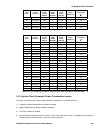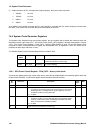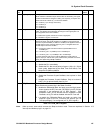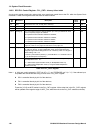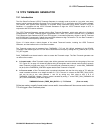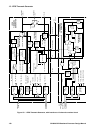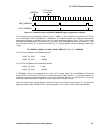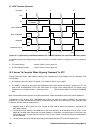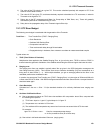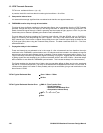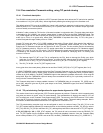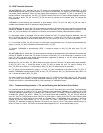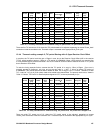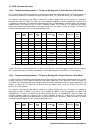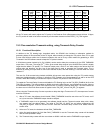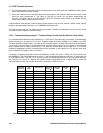15: 1PPS Timemark Generator
GP4020 GPS Baseband Processor Design Manual 153
iv) The value of the TIC period is at a given TIC. This can be calculated precisely with respect to UTC if the
Receiver Clock Offset is known.
v) The value of UTC at a given TIC, and hence the delay required to be added to a TIC occurrence, in order for
Timemark to be aligned to TIC.
vi) Delays due to the RF components and filters (i.e. Group-delay of SAW filters, etc.). These will generally
dominate any static error in absolute timing of 1PPS.
vii) Delay due to the propagation delay of the Timemark signal off the chip.
15.3 UTC Error Budget
The following error budget is associated with the generation of the Timemark:
Total Error = Time Transfer Error (TDOP * Ranging Error)
+ Clock Resolution
+ Oscillator Drift Residual Error
+ Computation induced Error
+ Time mark transfer delay through Drivers/cables.
+ Propagation delay in hardware, from antenna to correlator to measurement data sampler
Typical values are:
1. TDOP (Time Dilution of Precision):
Multiplication factor applied to the Satellite Ranging Error, to give a timing error. TDOP is similar to PDOP, in
that the better the geometric distribution of the satellites transmitting the received signals the lower the value.
2. Ranging error:
The ranging error from one satellite is typically about 30m as given in the GPS Navigation message as the
User Range Accuracy (URA). This includes errors due to Selective Availability (S/A) and corresponds to a
timing error of about 100ns (1 - σ). With multiple satellites, you get an averaging effect but the error in the
calculated position also contributes to this.
In practice, the worst-case Time-Transfer error (TDOP * Ranging Error) is in the region of 250ns and 300ns for
a worst case GPS-UTC offset. With DGPS the figure should be well under 50ns and with a surveyed location it
should be better again.
3. Clock Resolution:
Calculated as 7.2ns rms. = 25ns / √12 (the standard deviation of a uniformly distributed error ranging over
25ns)
4. Oscillator Drift Residual Error:
(a) Due to temperature change on TCXO since last oscillator drift computation: about 50ns, computed with
the following assumptions:
(i) TCXO max. slope is ±1 ppm/°C, typical slope is ±0.2 ppm/°C
(ii) Temperature max. variation is 5°C/minute.
(iii) The oscillator drift is computed every second and is at most one second old at UTC time mark.
For example:
1ppm/°C x 5°C/min x 1sec = 83ns for a temperature step change
or 41.5ns (rounded to 50ns) for a linear ramp.
(b) Due to bias in drift estimation about 50ns max. (rough guess)



